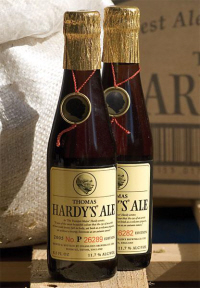First published in BEER December 2007 as part of a piece about strong beers for the festive season.
ABV: 11.7 per cent
Origin: Whimple, Devon, England
Website www.ohanlons.co.uk
When it comes to the festive season, I’m something of a bah humbug type by nature, but one of the things I do look forward to is venturing into my beer cellar. Or rather, the dark cupboard in which, for the past few years, I’ve had the remarkable self-discipline to stash bottles that deserve time to think about how they’re going to taste.
It’s not just a beer geek’s affectation – a good beer of reasonable strength really will develop complexity with age, especially if it’s bottled conditioned. Sharp hoppy flavours gain comfortably rounded corners, malt and fruit learn to mingle harmoniously and unexpected tastes emerge from the complex chemistry of secondary fermentation.
Setting a regular date to dip into your hoard is a good way of resisting the temptation to open the bottles too soon. And since many of the beers that benefit from cellaring make great winter warmers, enjoyed at leisure, the Yuletide holiday provides the perfect excuse.
Thomas Hardy’s is the ultimate British cellaring beer, and many readers will already be familiar with its fascinating story. Inspired by a quote from the eponymous novelist which still appears on the label, it was first brewed in 1968 to mark the 40th anniversary of his death. It was originated by family brewer Eldridge Pope of Dorchester, a town which, under the name Casterbridge, is a key location in Hardy’s Wessex novels.
Launching a super strength sedimented ale was an odd move at a time when most British brewers had abandoned bottle conditioning, slashed gravities and were now scrambling to dump cask. But someone at EP must have had faith that there was a niche in the market for a specialist brew and, as one of the famous five bottle conditioned British ales still in production at the inception of CAMRA, the ale became revered among the first generation of modern beer connoisseurs.
In 1997 the Dorchester brewery closed, a victim of the mania for severing brewing from retailing that gripped many traditional independents in the wake of the Beer Orders. Its famous strong ale joined the long list of lost classics until, in 2003, it was rescued thanks to interest from the burgeoning beer enthusiast community in the United States. The appropriately named Phoenix Imports of Maryland acquired the rights and commissioned first class microbrewery O’Hanlon’s to recreate the beer.
Thomas Hardy’s Ale is made mainly from pale malt and maltose syrup with only a touch of crystal malt – much of the colour comes from a long 200-minute boil. Hopped with Challenger, Goldings, Styrian Goldings and Northdown, it’s fermented for three months, hopped again and conditioned for two months before being bottled unfiltered with a vintage date. If looked after, it’ll continue to mature in the bottle for 25 years or more.
A 2006 vintage poured a delightful burgundy colour with very little head and low condition, and a sweetish cakey, winy and fruity aroma with a hint of figs. Fresh orange, peaches and marzipan fruit cake were evident on a smooth, nectar-like palate leading to a warming and very long finish with well-balanced burry hops, creamy toffee and a woody tang.
Bottles of the later Dorchester vintages have revealed soapy and peppery notes, spices, tannic red wine and marsala flavours. So don’t just buy one – get some spares and grow old gracefully together.
More strong festive beers in next post.
Read more about this beer at ratebeer.com: http://www.ratebeer.com/beer/ohanlons-thomas-hardys-ale-vintage-2003-and-later/31915/






I have two 1974 bottles in my secret cellar. I’m still trying to think of a suitably special occasion to open them. A Lottery win?
I have been offered a few bottles of this which are apparently from the original 1968 vintage. I’m not really sure whether to go for these as I have no idea of their value. Any ideas as to what price I should offer?